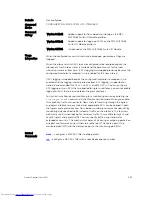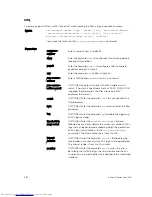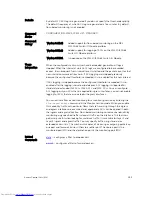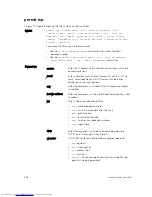
Version 9.3(0.0)
Added support for logging of ACLs on the MXL 10/40GbE
Switch IO Module platform.
Version 8.3.16.1
Introduced on the MXL 10/40GbE Switch IO Module.
Usage
Information
The
order
option is relevant in the context of the Policy QoS feature only. The
following applies:
• The
seq
sequence-number
command is applicable only in an ACL group.
• The
order
option works across ACL groups that have been applied on an
interface via the QoS policy framework.
• The
order
option takes precedence over
seq
sequence-number
.
• If
sequence-number
is not configured, the rules with the same order value are
ordered according to their configuration order.
• If
sequence-number
is configured, the sequence-number is used as a tie
breaker for rules with the same order.
When the configured maximum threshold is exceeded, generation of logs is
stopped. When the interval at which ACL logs are configured to be recorded
expires, the subsequent, fresh interval timer is started and the packet count for that
new interval commences from zero. If ACL logging was stopped previously
because the configured threshold is exceeded, it is re-enabled for this new interval.
If ACL logging is stopped because the configured threshold is exceeded, it is re-
enabled after the logging interval period elapses. ACL logging is supported for
standard and extended IPv4 ACLs, IPv6 ACLs, and MAC ACLs. You can configure
ACL logging only on ACLs that are applied to ingress interfaces; you cannot enable
logging for ACLs that are associated with egress interfaces.
You can activate flow-based monitoring for a monitoring session by entering the
flow-based enable
command in the Monitor Session mode. When you enable
this capability, traffic with particular flows that are traversing through the ingress
and egress interfaces are examined and, appropriate ACLs can be applied in both
the ingress and egress direction. Flow-based monitoring conserves bandwidth by
monitoring only specified traffic instead all traffic on the interface. This feature is
particularly useful when looking for malicious traffic. It is available for Layer 2 and
Layer 3 ingress and egress traffic. You may specify traffic using standard or
extended access-lists. This mechanism copies all incoming or outgoing packets on
one port and forwards (mirrors) them to another port. The source port is the
monitored port (MD) and the destination port is the monitoring port (MG).
Related
Commands
deny
— configures a filter to drop packets.
permit
— configures a filter to forward packets.
seq
— assigns a sequence number to a deny or permit filter in an IP access list
while creating the filter.
Access Control Lists (ACL)
265
















































